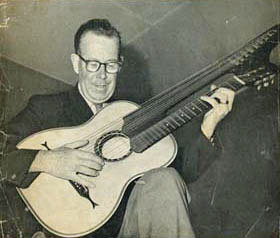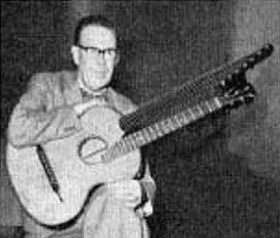Harp Guitar Player of the Month
|
Geoffrey Sisley, Contra-Guitarist |
||||
|
From B.M.G. Magazine, May, 1962
Commentary by Gregg Miner, March, 2009
|
||||
|
|
The author (not credited, perhaps editor A .P. Sharpe), seems to understand that, at the time, the majority of his readers had little first-hand knowledge of the instrument, as he explains as if to a child that "there are no frets on the bass neck!" While there are a multitude of common and regional tunings for the various stringing arrangements of contra-guitars, Sisley offers only the option of starting with Eb and descending chromatically (as far as the number of strings allow). More useful is his disclosure of his muting technique - stopping each sub-bass with his thumb knuckle. One wonders if this may be the traditional technique, since constant controlled damping is obviously necessary on these chromatic instruments. |
| Sisley owned, and the author describes, the two main forms of contra-guitar. This is nice to see, as it is an important topic that I have yet to address properly in our Photo Galleries (a rather monumental undertaking that I am still trying to draft expert Benoît Meulle-Stef into!). As Benoît noted, the photos in the article are reversed; the correct captions are at right. |
 German type contra-guitar |
 Viennese type contra-guitar |
|
Following is a transcription of the full article for easier reading (Click here for for full original article PDF)
Cover
Subject The instrument in our cover picture is a contra-guitar - a member of the guitar family on which Mr. Sisley has specialized during the past few years and readers may be interested in learning something of this traditional instrument. It has a wider body than the usual concert guitar but is generally shallower in depth; this last feature being a compensating factor regarding cubic capacity of the body, i.e. a wider soundboard for resonance but a shallow body to assist in the brilliant reproduction of the higher notes. The contra-guitar has two necks: one is a replica of the normal concert guitar, the other carries the added bass strings, which run down in chromatic scale order from low E string of the standard neck. Two kinds Contra-guitars
are broadly of two kinds. Firstly we
have the traditional and authentic Viennese contra-guitar, 13 to 15 strings in
all, with push-in pegs and a metal rod running inside the guitar body from the
heel to the extreme base of the instrument. This classical and national
instrument of It is
the usual thing in The other type of contra-guitar is the German type (illustrated in the photograph on this page) which, although still a double-necked instrument of broadly similar appearance as the Viennese instrument, differs in constructional details. The body of the instrument is more like the ordinary six-string concert guitar - but larger, of course. It is usually fitted with machine heads and may have 13, 15 or even 18 strings: the latter having a complete chromatic scale of twelve strings on the bass neck. Some conjecture There is, however, some conjecture as to the maintenance of tonal quality and volume of so large an instrument as compared with the 15 or 13 strings variety. Many people have asked Mr. Sisley how the contra-bass guitar is played, particularly in respect of the bass strings. He tells us that they are not fingered by the left hand (indeed, there are no frets on the bass neck!) as they are in chromatic order. These basses are therefore tuned thus: 13 strings contra-guitar (7 basses): Eb down to lower A. 15 strings (9 basses): Eb down to low G. 18 strings (12 basses): Eb down to low E. It will be seen that the first essential is a thorough knowledge of the chromatic scale, sharps and flats by name. The
playing of the basses are required to be controlled as regards their duration of
sound and as the contra-guitar is so extensively used for accompaniment, let us
deal with this aspect of the instrument. The bass strings are damped (after they
have sounded for the desired length of sound) by touching the string with the
lowest knuckle joint of the right-hand thumb. It should, perhaps, be emphasized
that the clarity of the note is not thus impaired as in the plectrum guitar
effect of actually damping the initial note with the outer edge of the
right-hand palm. With the contra-guitar, the sound (though short) is clear. Another advantage the contra-guitar enjoys is that playing in the usually-avoided flat keys is facilitated by the fact that comparatively simple chord formations can be employed on the treble neck as the player has, in most cases, the fundamental and alternative basses already on the bass neck. That is the normally problematical keys of Bb, Eb, Ab Db, Gb and Cb [?] present no real problems to the player of the contra-guitar. |
|
If you enjoyed this page, or found it useful for research, please consider supporting Harpguitars.net so that this information will be available for others like you and to future generations. Thanks!
|
|
All Site Contents Copyright © Gregg Miner, 2004,2005,2006. All Rights Reserved. Copyright and Fair Use of material and use of images: See Copyright and Fair Use policy. |
|
|
|
All Site Contents Copyright © Gregg Miner, 2004,2005,2006,2007,2008,2009. All Rights Reserved. Copyright and Fair Use of material and use of images: See Copyright and Fair Use policy. |